INDEX AND CHRONOLOGY OF GRAVITRAM SCULPTURESThe index below lists Gravitram sculptures in chronological order. Some are stereoscopic photographs which you can free-view as parallel pairs, or use a stereoscope for screen viewing if you can't free-view stereo pairs. To find out more about stereo viewers go to the Stereoscopic Viewers page. Click on the small photos below to get to a larger photograph of Gravitrams. |
||
| Gravitram One at OMSI, Portland,
Oregon USA - September 20, 1973
I have been asked many times how did I come up with the idea of the Gravitram and how was it made. I have already given a short account regarding the general inspiration mainly from the work of the Swiss sculptor Jean Tinguely but also from the work of other kinetic sculptors in the 1950s. The specific ideas about the Gravitram however where the result of tinkering with balls, rolling these in channels and trying to attach some logic to this tinkering. Thus for example, knowing the principle of how a logic flip-flop switch works in the "either" or the "or" position, or the principle of the binary counter was helpful in translating those concepts to mechanical gates that mimic or are analogous to the logic switches. So I started making mechanical switches, gates, "memory" devices, accelerators and other mechanical "tricks", making sure that one or two balls will roll and activate those and putting those aside. This was happening during the first years of my association with the Oregon Museum of Science and Industry in Portland, Oregon, USA. I got one of my very talented colleagues to tinker with me during our lunch hours and we were making lots of individual components. I didn't know yet how they will be connected, but after we had enough parts, we made a large metal frame, and constructed two elevators to take the balls to the top of the frame. One was an auger the other a chain elevator. |
||
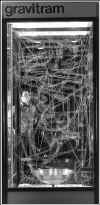
|
Once I had the means to take the balls to the
top of the structure I started constructing the tracks so I could roll the
balls down. This was the creative stage - to arrange the tracks and
connect the "tricks" in a visually pleasing and logical fashion.
The tracks and tricks were all made of copper plated, 1/8" mild steel
rod used in welding. These were brazed together. Most of the parts were
fabricated from scratch, although we used some "found" objects,
such as the large dish at the bottom where the balls circled for a long
time before falling into a hole. Eventually, enough people got interested
in what we were doing during our lunch brakes that the director of the
museum, Loren McKinley, allowed me to work on this project full time.
After more than 500 hours that my colleague George Hohnstein and I put
into this sculpture, it was ready to be run "for real" and we
placed it on the main floor of the museum. The picture on the left was
taken at the inauguration of the Gravitram, on September 20, 1973. The
name Gravitram is my "invention" and is derived from two words: GRAVIty
and TRAMway. Some people insist on calling those sculptures "Gravitron"
which sounds nice, but is not the real name. Although repaired many times
since 1973, the original Gravitram is still on display and functioning at
OMSI, the Oregon Museum of Science and Industry. The original Gravitram,
is 10 feet tall and 4 feet on each side. It is encased in a glass cage and
uses 1" bearing balls. It has internal illumination.
The stereoscopic photograph on the left was taken by the author on January 16, 2002 - almost 29 years after the one above it. In these fast changing times, it is remarkable to note the only change in the original Gravitram are the Graphics in the title. It is also remarkable that this single exhibit has survived a move to another building, a flood, and has been a favorite of visitors, young and old, longer than any other exhibit at OMSI. |
|
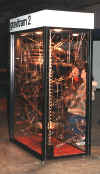 |
Gravitram 2 at the Omniplex Science Center in Oklahoma City, Oklahoma, 1978 As one Gravitram was sufficient for OMSI, and as I craved to create more of these sculptures, I started working in the evenings and weekends in my own basement on commissioned Gravitrams. The height of my basement determined the height limit of the next 4 sculptures to under 8 feet. On the left is Gravitram 2 in Oklahoma City. It has a glass cage, internal illumination and measures 60" x 36" x 84" and is made of 1/8" steel rods with 1" bearing balls. On the right is a photograph of my son Ariel taken just before shipping of the Gravitram to Oklahoma. Ariel is 6 years old in this photo and 21 years later, he will build his first Gravitram for the Science Place in Dallas, Texas. See the Dallas Gravitram below. |
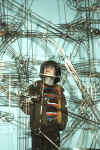
|
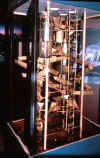 |
Hydro-Gravitram at the Children's Museum in Portland, Oregon, 1983It was only natural that at certain point I would be looking for different media to be used in kinetic sculptures based on gravity. The opportunity presented itself when the City of Portland commissioned me to create a sculpture that would be a centerpiece at a water conference in New Orleans in 1983. Portland boasts as having one of cleanest drinking water supplies in the country and it needed a "catchy" show piece to show off. Creating this sculpture required again rethinking of the use of materials, methods and encountering new challenges. The mainstay of the first Gravitram, the flip-flop gate, was used successfully here as well, this time the water flipping the gates as they were filled. The number of "tricks" was limited compared to rolling balls, nevertheless, gentle water hammers, water ladders and other means to slow down the flow of water were important features of this sculpture. The main material in use was copper plate which was silver-soldered together. At the end of the water conference, the City donated the sculpture to the old Children's Museum where it was enjoyed by kids for several years before bureaucracy caught up with it and no funds were available any longer to maintain it. I was told at the time that the sculpture had been lost. In July of 2011 I received information from the Portland Water Bureau that the sculpture is in storage and has been stored for many years in one of the department's warehouses. "Would I like to see it" was the next question. This led to a visit to the warehouse and to my delight the sculpture was there, albeit in a bad shape and missing several of the original components. Thus the renovation of this sculpture began and it is being documented on its own page here. |
|
 |
Gravitrek at the Children's Hospital in Portland, Oregon, 1984 (Destroyed)I was commissioned by the hospital and a prominent art gallery owner, its benefactor, to create a sculpture for the lobby of this children hospital. I decided to approach this project and create a sculpture that is interactive, bold, colorful and whimsical at once. One wall of my large family room served as the "easel" on which the structure was bolted, constructed and eventually removed for permanent installation in the hospital. This was a very large structure measuring over 18 feet in length, 9 feet tall (including the housing) but less than 2 feet deep. The largest balls used in my sculptures, 5" in diameter white plastic, rolled gently in hardwood tracks. The Gravitrek had a handle which the kids used to lift the balls to the top to start them rolling down. The operation was very smooth and soft and almost no noise resulted from the moving balls. The only exception were the chimes which one can see at the top, triggered by the balls. By no means a musical instrument, nevertheless a musically tolerant visitor could definitely recognize the first few notes from Schubert's "Unfinished Symphony". Like the fate of the Hydro-Gravitram, this sculpture too, met with the harsh institutional bureaucracy of the hospital, and with the lack of funds to transfer it to a new lobby, it was destroyed and lost forever. |
|
 |
Gravitram 3 at the Science Museum in Lahore, Pakistan 1985The third Gravitram had still all the same elements and design approach as the previous two. It used 1" bearing balls, and 1/8" rods and had the steel bowl feature at its bottom. The departure from this design approach would start with the next Gravitram. Size is 60" x 40" x 84" enclosed in a glass case and it has internal illumination and two elevators.
|
|
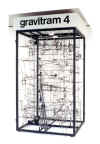 |
Gravitram 4 at the Museum of Science and Industry in Louisville, Kentucky 1986The design of this Gravitram signals a departure from the 1" steel balls used in the previous 3 sculptures. Now a larger, bolder ball is introduced, requiring the rethinking of many of the engineering challenges of the structure. Here for the first time a hard plastic 2" ball is used, and the familiar bowl is gone. Gravitram 4 introduces also many additional features not seen in the first 3 sculptures. The most significant of these is a chaotic pendulum powered by the moving balls and seen at rest in the left picture and in partial movement in the stereo pictures on the right. The outside size of this Gravitram is the same as Gravitram 3, it is 60" x 40" x 84" and it is enclosed in a glass case with internal illumination. |

|
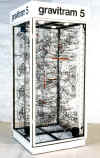 |
Gravitram 5 at Questacon in Canberra, Australia 1987This was the last and tallest Gravitram built at home in a temporary structure I constructed in my back yard. It measures 50" x 50" x 90", has a glass enclosure with internal illumination and uses 2" hard plastic balls. Like in Gravitram 4, the tracks are made of 3/16" mild steel rod brazed together. It features additional "tricks" such as rapid descent "tubes" using helical construction and many swinging and rotating gates. The photo on the left was taken just prior to shipping the Gravitram to Australia and the one to the left below it, shows it on site at the National Science and Technology Centre in Canberra, Australia. The photo on the right was taken in Canberra and shows a typical reaction from a young visitor to the Centre. Gravitram 5 was the last one to be given a sequential number. From here on, Gravitrams simply acquired the name of the location where they were installed. |
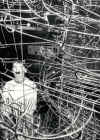
|
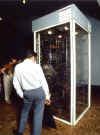 |
||
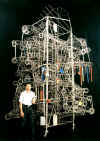 |
Gravitram (Israel) at the Weizmann Institute of Science, Rehovot, Israel 1992In 1989, after a couple of years in a temporary location, I acquired a 6,000 sq. ft. building, incorporated my business (Levy Design, Inc.) and moved my operations to this charming new site in what would eventually become the trendiest neighborhood in Portland, Oregon, anchored by what the locals call "Twentythird". The new studio and shop on NW Quimby St, off 23rd Ave., features 24 foot clear story ceiling and ample space equipped with new machinery and tools. Thus, the limit on the height of Gravitrams was lifted and I was ready for new challenges. The first Gravitram to be created here was commissioned by the "Garden of Science" a science education center which is part of the Weitzmann Institute of Science, in Rehovot, Israel. Now with a full crew to design and build science museum exhibits, I had additional help to continue to create Gravitram sculptures as well. This was the largest single-piece Gravitram up to that time, although later, another Gravitram of a similar size with two main components would be created for a museum in Brazil. Like previous progress in creating Gravitrams, this one posed new engineering challenges. The 4" hard plastic balls had to roll in strong tracks, which could not be bent or shaped by hand any more. New equipment for bending was acquired, and the new shop machines, which were used mostly for fabrication of science exhibits, came in very handy as well. This was the only Gravitram that was designed as an outdoor sculpture, so everything had to be built to withstand the elements. We used 3/8" stainless steel rod, and all other parts were also made of stainless steel. We designed special "universal" connectors, which allowed to pre-fabricate many of the components and then bolt those together. Welding of rods and other components was done with a TIG welder. The structure was strong enough to withstand the elements and certainly the weight of 10 of the 15 member crew at Levy Design at that time. (Top right) On August 29, 1994, about two years after the installation of the Gravitram in Israel, Prime Minister Itzhak Rabin (bottom left photo, on left with glasses) visited the Institute and was shown the Gravitram by the President of the Weitzmann Institute, prof. Haim Harrari. (Bottom photo, on right with glasses.) Rabin was tragically assassinated in 1995 by a right-wing extremist in Tel Aviv. At the extremes, this Gravitram measures 108" x 108" x 160" and has no enclosure. |

|
 |

|
|
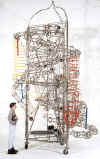 |
Gravitram (Saudi Arabia) at the Jeddah Science Center, Jeddah, Saudi Arabia 1993Like the Gravtram for Israel, this one featured many of the same design elements and a similar structure, although unlike the above, this was done as an indoor sculpture. The Israeli Gravitram introduced a new feature, a trampoline from which the ball bounces up in the air and precisely hitting a funnel to continue with its travel. Other elements used previously were also incorporated in this Gravitram such as "loop the loop", musical chimes, helical tubes, etc. It measures 100" x 100" x 160" it is made of 3/8" stainless steel rods and uses 4" hard plastic balls. The bottom right photo shows a stereoscopic picture of the Gravitram. |

|
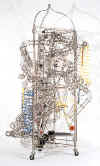 |

|
|
 |
Gravitram (Brazil) at the University Museum in Porto Alegre, Brazil 1995Unquestionably, the largest and the most complex Gravitram that I have been involved in was the one we created for the Brazilian museum. Structurally, it is made similarly to the Israeli and Saudi Gravitrams from 3/8" stainless steel rods and uses 4" plastic balls. Functionally however, it marks the most significant departure from any previous Gravitram in that it allows the visitor to control to a great degree where and how the balls will roll. To achieve this, we designed the gates to be operated by pneumatic devices and to be controlled by a computer from a touch screen housed in the front console. The same console houses also a compressor which is necessary for the operation of the pneumatics. The visitor designates the sequence and position of the gates to be operated and launches the program. Program sequences can be combined and repeated to achieve a complex and long run. The Gravitram measures 10' x 10' x 14' and is enclosed in a glass case. The computer console measures approximately 4' x 3' x 3'. |

|
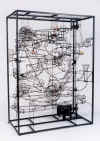 |
Gravitram (Los Angeles) at the Petersen Automotive Museum in LA, CA 1997Commissioned by the Petersen Automotive Museum in Los Angeles, this smaller Gravitram uses 3/16" stainless steel tracks, 2" plastic balls and measures 60" x 40" x 84". It is enclosed in a glass case without internal illumination. The photo on the right shows a stereoscopic photograph of this Gravitram. |

|
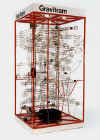 |
Gravitram (Dallas) at The Science Place in Dallas, Texas 1999The Gravitram in this series was created entirely by my son Ariel Levy during one of his summer vacations while working on his master's degree in civil engineering. Ariel grew up in a creative environment where one could observe the creation of Gravitrams, and many other scientific exhibits. Picking up quickly and easily the needed skills and using his own creative talents, he built this 50" x 50" x 90" Gravitram. It has 3/16" stainless steel tracks and uses 2" hard plastic balls. |
 |
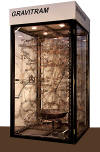 |
Gravitram (Wichita) at Exploration Place Science Center in Wichita, Kansas, March 2010The latest Gravitram in this series was created by father-son team of Shab and Ariel Levy. This Gravitram is the 14th in the series and was created 37 years after the first one on this page. Its base measure 4' x 4' and is 8' in height. It uses 1" ball bearings and features a few new "tricks" not found in previous sculptures. The tracks are made of 1/8" copper-coated steel rods. The photo on the right (click) is a 3D anaglyph of the Gravitram. |
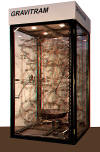 |

